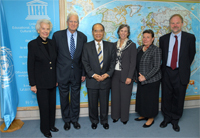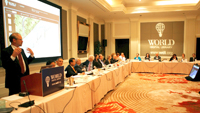 March 2011 - The World Digital Library sounds improbable at first – many nations providing open access to highlights of their cultural history, all in one place. But that’s exactly what it is.
March 2011 - The World Digital Library sounds improbable at first – many nations providing open access to highlights of their cultural history, all in one place. But that’s exactly what it is.
Back in 2005, Librarian of Congress James H. Billington had a vision for just such a venture, and approached officials at UNESCO with the idea. An agreement was drawn up a year later, then a year after that (a mere blink of an eye in government time) a prototype website was unveiled. In 2009, the site was officially launched at UNESCO headquarters in Paris.
The WDL mission statement provides a good overall description of the project, "The World Digital Library makes available on the Internet, free of charge and in multilingual format, significant primary materials from countries and cultures around the world."
Looking at and using this web collection (external link) is not like visiting your average government site – it has a visual appeal that puts it in a whole different category. When Library of Congress staff comment on this site, they invariably say things like, "I wish our website looked more like the WDL." And this is a tough crowd to please.

Marjorie Billington; Librarian of Congress James Billington; Koïchiro Matsuura, former Director-General of UNESCO; Louise Oliver, former U.S. Permanent Representative to UNESCO; Laura Campbell, CIO of the Library of Congress; John Van Oudenaren, Director of the World Digital Library at UNESCO to celebrate the launch of the WDL prototype in 2007.
But beyond the pretty face, there is substance and scholarship - a way to collaborate and provide access to world culture and history. Among the major features is its multilingualism – all of the item descriptions, information about the project and navigation are presented in seven different languages (Arabic, Chinese, French, Portuguese, Russian, Spanish and English.). All in all, there are over 40 languages represented in the content items themselves.
To date, there are about 1,460 digital items included in the World Digital Library, in a variety of formats – books, photographs, films, sound recordings, manuscripts and maps. Among the content highlights are many rare items: illuminated books and manuscripts from Europe, Arabic scientific manuscripts from the National Library and Archives of Egypt, early photographs of Latin America from the National Library of Brazil, and what is generally considered to be the first great novel in world literature, The Tale of Genji, written by a Japanese woman named Murasaki Shibuku in the early 11th century.
And how is the content chosen? According to John Van Oudenaren, the director of the project, each WDL partner proposes content to contribute. A content selection committee, made up of representatives from partner institutions, has established standard selection guidelines. Each institution contributes the digitized objects and associated metadata. Van Oudenaren is pleased with the results, and says "we’ve been very happy with the quality of the content selected by the partner institutions for the WDL. Many items are top treasures, such as the famous "Devil’s Bible (external link)" from the National Library of Sweden or the Codex Colombino (external link) from the National Institute of Anthropology and History. We’ve also had very nice contributions from our U.S. partners: Yale University, the John Carter Brown and the Brown University libraries, the State Library and Archives of Florida, and several others. And a lot more is in the pipeline or has been pledged."
Then there is the viewing experience – the WDL site provides multiple ways to search and browse content, including by place, time, topic, type of item and contributing institution. And every item can be viewed with state-of-the art zoom features in order to catch all the fine detail. This comes in handy for photographs with particularly rich detail, such as "Mulberry Street (external link)" from the Library of Congress collections, and illuminated medieval manuscripts such as the 15th century "Letter to Philocrates (external link)" contributed by the Bavarian State Library, and many others.

Representatives of World Digital Library partner institutions meet in Washington, DC in June 2010.
Rago noted that, "Our intent was to design a site that would be visually interesting to explore and that would appeal to non-traditional digital library users. There is a lot more we hope to do with the interface and functionality, including optimizing the site for mobile devices. As we try to increase awareness about this content in certain parts of the world, mobile access to the WDL site will become even more important."
The Library of Congress is managing the overall project, including coordination of the technical side - that is, content transfer, image processing, cataloging, translation, website design and application development. The Library also coordinates the governance of the project which includes establishing a charter, organizing partner meetings, securing funding, and recruiting new partners. The WDL currently has 122 partners from 66 countries, including many prominent national and university libraries. "We ultimately hope to have at least one partner from every country," said Rago.
The site has garnered some accolades, even in its first year, as it was named one of PC Magazine’s "Top 100 websites for 2009." As of the end of 2010, over 13 million site visitors viewed 90 million pages. Of the seven WDL languages, the Spanish version of the site has received the most use.
Rago notes that, moving forward, the main goals will be to add more content to the site and to focus on outreach and community building. In the meantime, the World Digital Library continues to attract visitors from all over the globe – and to provide access to some of the world’s greatest cultural treasures.
